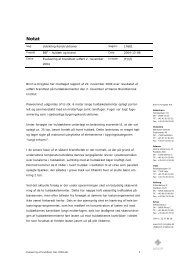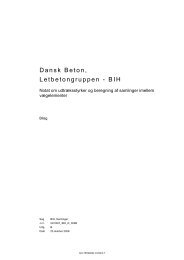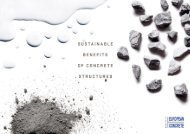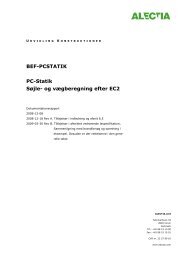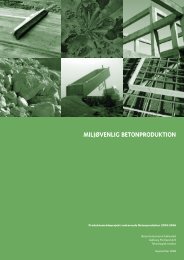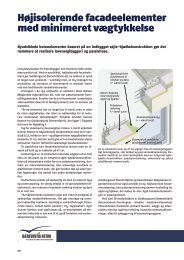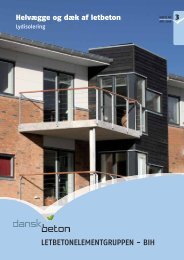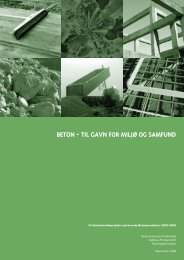The Concrete Industry Sustainability Performance Report ...
The Concrete Industry Sustainability Performance Report ...
The Concrete Industry Sustainability Performance Report ...
- No tags were found...
Create successful ePaper yourself
Turn your PDF publications into a flip-book with our unique Google optimized e-Paper software.
Our visionOur vision is that, by 2012, the UKconcrete industry will be recognised asthe leader in sustainable construction,by taking a dynamic role in deliveringa sustainable built environment ina manner that is profitable, sociallyresponsible and functions withinenvironmental limits.Who we are<strong>The</strong> UK <strong>Concrete</strong> <strong>Industry</strong> is represented by the trade associations andcompanies who have signed up to the <strong>Concrete</strong> <strong>Industry</strong> SustainableConstruction Strategy. This strategy includes the commitment tocontinual improvement, measurement and reporting of performancedata for the industry. <strong>The</strong> concrete industry represents nine productionsectors that together provide ready-mixed concrete, precast concreteand on-site batch plants. In 2008 the UK concrete industry produced 102million tonnes of concrete, playing a vital role in the construction of ourbuilt environment.Our reportIn this report the concrete industry’s sustainability performance in 2008 ispresented. <strong>The</strong> data is based on information supplied by the aggregates,cement, chemical admixtures, fly ash, ground granulated blast furnaceslag, precast and ready-mixed concrete sectors. <strong>The</strong> information isfrom survey responses from companies supplying an estimated 77%of concrete used in the UK.Introduction<strong>Concrete</strong> is our most widely used construction material andis essential for the sustainable development of our housing,schools, hospitals, transport networks, energy infrastructureand our built environment.In 2008 the UK concrete industry agreed a <strong>Concrete</strong> <strong>Industry</strong> SustainableConstruction Strategy. This pledge to sustainability objectives was signed bytrade associations and companies and included the commitment to publishan annual report on the sustainability performance of the industry.<strong>The</strong> individual sectors and companies had already established initiatives andreporting structures. <strong>The</strong> commitment to a comprehensive industrystrategy and report has required coordination and further developmentof sector and company processes. In addition, the industry performanceindicators were developed to support the UK Government’s sustainableconstruction strategy. In March 2009 the industry published its first <strong>Concrete</strong><strong>Industry</strong> <strong>Sustainability</strong> <strong>Performance</strong> <strong>Report</strong> and marked the event with alaunch to key stakeholders.This second report, published in March 2010, signifies another industrymilestone; the agreement to publish performance targets. With 12 targetspublished in this report and more in development, this report reflects ourcommitment to transparency and continual improvement. We will continueto further develop and refine the reporting framework across our industry.We are also increasing the scope of the industry captured by the reporting.Already the British Association of Reinforcement has signed up to thestrategy and future reports will include performance data from this sector.<strong>The</strong> concrete industry is the first industry to link our sustainable constructionstrategy to the responsible sourcing standard developed by the BuildingResearch Establishment (BRE), BES 6001 - “Framework Standard for theResponsible Sourcing of Construction Products”. This demonstrates theexcellent credentials of the UK concrete industry and enables designers toeasily source accredited material and gain maximum credits in sustainabilityassessment tools such as the Code for Sustainable Homes.<strong>The</strong> industry would like to thank those stakeholders who participated in oursurvey and provided feedback on our first report. <strong>The</strong> report was welcomedand the industry was commended for its achievements and commitmentsto sustainability. If you would like to comment on this second report pleaseemail: sustainability@concretecentre.comFront cover image: John Madjeski Academy, Reading utilises an in-situ concrete frame, exposed precast concrete and blockwork; providing a sustainable learning environment and community building.02
CONCRETE INDUSTRY SUSTAINABLE CONSTRUCTION TARGEtSUK Government‘Shared Priority’<strong>Sustainability</strong>Principle<strong>Performance</strong> Indicator<strong>Performance</strong>2008Target 2012Sustainable Consumptionand ProductionEnvironmental Management percentage of production sites covered by a ‘UKAS’ Environmental Management System (EMS) 72.3% Increase to 85%Waste Minimisation kilogram of waste to landfill as a proportion of production output (in tonnes) 5.0kg / t Reduce by 15%Emissions (excluding CO 2) number of convictions for air and water emissions per annum 6 Reduce to zeroStakeholder Engagement<strong>The</strong> industry sectors have successful and wide ranging stakeholder schemes in place.An industry wide measure is being developed to aid future industry reporting.Quality and <strong>Performance</strong> percentage of production sites covered by a ‘UKAS’ certified 9001 quality management system 84.2% Increase to 90%Climate Change and Energy Energy Efficiency kilowatt per hour of energy used in production as a proportion of production output (in tonnes) 132.6 kWh / tDeliver the industry CO 2target and achievesector climate change agreement targetsCO 2Emissions - productionkilogram of CO 2emissions as a proportion of production output (in tonnes)(1990 baseline is 103.1 kg CO 2/ t )88.1kg CO 2/ tReduce by 17% from 1990 baselineCO 2Emissions - transportData exists at a sector level. To enable combined industry reporting a common methodology is being developed.Natural Resource Protectionand Enhancing the Environmentmaterial diverted from the waste-stream for use as a fuel source as a percentageof total energy use17.3% Increase to 21%Materials Efficiencypercentage of additional cementitious materials (GGBS, fly ash, etc) as a proportion of totalcementitious materials used31.8% Increase to 33%recycled/ secondary aggregates as a proportion of total concrete aggregates 5.3%Water mains water consumption (in litres) as a proportion of production output (in tonnes) 86.1 l / tThis indicator is to be refined beforea target is setThis indicator is to be refined beforea target is setSite Stewardship and Biodiversity percentage of relevant production sites that have site specific action plans 94.3% Increase to 100%Creating Sustainable Communities Health and Safety reportable injuries per 100,000 direct employees per annum 799 per 100,000From 2009-2014, reduce lost timeincidents by 50% with an aim of zero harmEmployment and Skills percentage of employees covered by ‘UKAS’ certified training and evaluation processes 84.4% Increase to 100%Local Community percentage of relevant sites that have community liaison activities 85.9% Increase to 90%03
1. Sustainableconsumptionand production<strong>Performance</strong><strong>Performance</strong> Indicator 1: EnvironmentalIndicatormanagement<strong>Performance</strong> Indicator 2: Waste minimisation<strong>Performance</strong> Indicator 3: Emissions (excluding CO 2)<strong>Performance</strong> Indicator 4: Stakeholder engagement<strong>Performance</strong> Indicator 5: Quality and performanceto landfill from the production of concrete andits constituent materials is 0.28 million tonnes.Meanwhile these companies diverted over 5 milliontonnes of material from the waste stream and usedthem instead of primary materials.Waste MinimisationAlthough not widely recognised, the concreteindustry uses over 18 times more waste, by-productsand secondary materials from other industries thanthe waste it sends to landfill. For the companiesproviding data in this report the estimated total waste<strong>Performance</strong>Indicatorkilogram of wasteto landfill as aproportion ofproduction output2008<strong>Performance</strong>2012Target5.0 kg/t Reduceby 15%Much investment and activity has contributed to analready excellent level of performance. <strong>The</strong> industrywill continue to target improvements through:- increased use of by-products and secondarymaterials in the production process.- reduction of waste to landfill, with an aim toexceed the commercial and industrial waste targetpublished by Defra in England and Wales WasteStrategy 2007.- working with the wider construction industryto support innovations and initiatives to helpin achieving the UK Government SustainableConstruction Target of a 50% reduction inconstruction waste to landfill.Environmental ManagementISO 14001 gives a structure to EnvironmentalManagement Systems (EMS) that is beneficial to bothenvironmental and business performance. Sites acrossthe industry vary in their size and complexity fromcement works to concrete batching plants. <strong>Industry</strong>coverage of ‘UKAS’ certified systems is 72% (or 1173sites) and we are working to increase this coverage.By 2012 we aim to achieve an increase to 85%. Basedon the number of sites in 2008 this would equate toan additional 206 sites gaining accreditation.<strong>Performance</strong>Indicatorproduction sitescovered by a ‘UKAS’certified EMS *2008<strong>Performance</strong>* such as ISO 14001, EMAS and for SMEs, BS 8555.2012Target72.3% Increaseto 85%<strong>Concrete</strong> is the first materialto gain responsible sourcingaccreditation to BES 6001.<strong>Concrete</strong> products canachieve the highest tier ofresponsible sourcing in theCode for Sustainable Homesand BREEAM.Responsible Sourcing<strong>The</strong> target set by Government in its SustainableConstruction Strategy target is at least 25%of construction materials should be suppliedfrom suppliers with responsible sourcingcertification by 2012. <strong>The</strong> concrete industryhas taken significant steps to exceed this andhas published <strong>Concrete</strong> <strong>Industry</strong> Guidance forthe BRE Framework Standard for ResponsibleSourcing (BES6001) to facilitate the earlycertification of a significant proportion ofconcrete to the responsible sourcing standard.For information on companies certified to BES6001 visit www.greenbooklive.com04
Stakeholder Engagement<strong>The</strong> nine production sectors, which make upthe concrete industry supply chain, engage withnational and international stakeholders to improvethe sustainability of the material and the builtenvironment.For example, companies and trade associations haveworked with BRE to provide detailed performancedata to support the production of generic productenvironmental profiles and Green Guide information.<strong>The</strong> concrete industry is also engaged with theconstruction industry to improve the sustainableperformance of the supply chain and also theend product - whether a building, house, orinfrastructure project.<strong>The</strong> industry engagement in local communities isincluded in the Local Community sustainabilityprinciple, see page 11.Quality & <strong>Performance</strong><strong>The</strong> majority of the concrete supply chain is certifiedby Quality Management Systems. <strong>The</strong> target is toincrease the total number of concrete industry sites,which equates to 103 additional sites (based on 2008figures) gaining accreditation.<strong>The</strong> industry is also improving the coordination ofresearch and development. <strong>The</strong> objective of this is toincrease the level of innovation and the developmentof more sustainable products and services.<strong>Performance</strong>Indicatorpercentage ofproduction sitescovered by a UKAScertified 9001 qualitymanagement system2008<strong>Performance</strong>2012Target84.2% Increaseto 90%Emissions (excluding CO 2 )<strong>The</strong> nature of emissions varies across thedifferent sectors of the industry. Emissions arewell managed by the sectors and monitoredby regulatory bodies, with significantimprovements being recorded. A commonindicator used in monitoring emissions isconvictions for non-compliance.<strong>Performance</strong>Indicatornumber of convictionsfor air and wateremissions per annum2008<strong>Performance</strong>2012Target6 Reduceto zeroEach trade body is focused on best practice inemissions reduction. <strong>The</strong> target for 2012 is forall the sectors of the concrete industry to achievezero convictions.<strong>The</strong> cement sector is a key part of the concreteindustry and through major investment has achievedsignificant environmental improvements. Forexample, particulate emissions have been reducedby two thirds, oxides of nitrogen have been halvedand sulphur dioxide emissions are now a quarterof the 1998 level. For more information visitwww.cementindustry.co.uk05
Unlike other construction materials, the UK can beself-sufficient in concrete. With a local supply networkconcrete is the local material.CO 2Emissions - ProductionCO 2emissions from cement production make upabout 85% of the total CO 2emissions associatedwith concrete production. Through investment innew technology and use of biomass fuels, significantreductions have been achieved and there has beenan estimated 14.6% decrease in CO 2emissions fromcomparable concrete mixes between 1990 and 2008.Our concrete industry target to reduce emissions ofCO 2from production is based on verifiable baselinedata from the cement industry going back to 1990(to match the UK Government’s baseline).Future improvements will be the result of actionthroughout the concrete supply chain, through thesubstitution of fossil fuels by waste-derived fuels incement manufacturing and by the use of recycledand low carbon constituent materials (subject to theiravailability and maintaining product quality).For information and useful data for carbon calculatorsrelating to the CO 2emissions associated with an‘average’ tonne of concrete, which includes waterand steel reinforcing bar, visitwww.sustainableconcrete.org.uk<strong>Performance</strong>Indicatorkilogram of CO 2emissions as aproportion ofproduction output2008<strong>Performance</strong> 2012Target88.1 kg CO 2/t(1990 baselinefigure of 103.1kg CO 2/t)Reduce by 17%from 1990baselineCO 2Emissions - transport<strong>The</strong> local supply network for concrete means thatdelivery distances are short and the fuel used duringhaulage (and the associated CO 2emissions) isminimised. <strong>The</strong> average delivery distance of readymixedconcrete to the construction site is eight km,and just over 150 km for precast concrete products.Data collection on transport CO 2is improvingby sector and during 2010 we will focus onthe development of common data collectionmethodologies and guidelines to allow the concreteindustry to report transport CO 2emissions.07
WaterWater is an important resource and the concrete industry utilisesrainwater harvesting schemes and water recycling to reduce demandfor mains water.Water is an ingredient of concrete and a cubic metre of fresh concretecontains 140 to 190 litres of water. <strong>The</strong> use of admixtures can reduce thewater content by up to 30 litres per cubic metre. 90% of ready-mixedconcrete already includes water reducing admixtures.In 2008 86.1 litres of mains water was used per tonne of concrete.We are making a substantialcontribution to biodiversity inthe UK, including initiativeswith Natural England and theRSPB to provide spaces forpeople and wildlife to enjoy.In addition to mains water use, the concrete industry is also monitoringgroundwater use. <strong>The</strong> aim is to reduce the overall water use of theindustry and once a benchmark has been established from consistentreporting, the industry will set performance targets.<strong>Performance</strong> Indicatormains water use2008<strong>Performance</strong>86.1 l/tcontrolled groundwater use not available for 20082012TargetThis indicatoris to be refinedbefore a targetis setSite Stewardship and BiodiversityEffective site stewardship requires management of biodiversity,geodiversity and heritage. Seven hundred sites of special scientificinterest (SSSI’s) in the UK are current and previous sites of mineralextraction.<strong>Performance</strong> Indicatorpercentage of relevant production sitesthat have site specific action plans2008<strong>Performance</strong>2012Target94.3% 100%<strong>The</strong> aggregates sector is actively involved in site stewardship andbiodiversity initiatives, including encouraging exemplar restorationprojects.<strong>The</strong> minerals industry is actively supporting the Nature After Mineralsinitiative of RSPB and Natural England, designed to encourage greaterawareness and understanding of the opportunities for habitat creationand biodiversity; see www.afterminerals.com. For more informationon these and other heritage, restoration, biodiversity and geodiversityinitiatives, please refer to the Sustainable Development <strong>Report</strong>s on thewww.mineralproducts.org website.09
4. CreatingSustainableCommunities<strong>Concrete</strong> productscertified to BES6001 can achievethe highest tier forResponsible Sourcingin the Code forSustainable Homesand BREEAM.We recognise that even asingle injury is unacceptable.Significant progress has beenmade to reduce incidents,but more must be done toachieve the overall objectiveof zero harm.<strong>Performance</strong> Indicator 1:<strong>Performance</strong><strong>Performance</strong> Indicator 2:Indicator<strong>Performance</strong> Indicator 3:<strong>Performance</strong>Indicatorreportable injuriesper 100,000 directemployees peryear*2008<strong>Performance</strong>Health & SafetyEmployment & SkillsLocal Community2012Target799 per 100,000 From 2009-2014,reduce lost timeincidents by 50%with an aim ofzero harm* <strong>The</strong>re were 282 reportable injuries in the UK concrete industry in 2008(recorded by companies contributing to this report.)Health and Safety (H&S)<strong>The</strong>re have been significant improvements in thehealth and safety performance of the concreteindustry and associated sectors, but further progressis required. While the current H&S indicator focuseson reducing reportable injuries to employees,industry targets will increasingly be focussed on thereduction of ‘Lost Time Incidents’ and the overallobjective of ‘Zero Harm’. A number of improvementprogrammes are in place, developed in partnershipwith the Health and Safety Executive (HSE), topromote best practice.<strong>The</strong> timeframe for the concrete industry of 2009-2014is as agreed with the HSE.Employment and SkillsEmployment: <strong>The</strong> concrete industry is asignificant employer in the UK, often supportingrural communities that have limited alternativeemployment opportunities.Skills: <strong>The</strong> current indicator of performancein workforce skills is based on the Training &Competence section of certified Quality andEnvironmental Standards. This requires that relevantskills gaps are identified for all employees, thecreation of a plan to address these, and the auditingand certification of this process to ensure the trainingis delivered and that it is effective.<strong>Performance</strong>Indicatorpercentageof employeescovered by ‘UKAS’certified trainingand evaluationprocesses2008<strong>Performance</strong> 2012Target84.4% Increase to 100%Work is also underway to develop a more specific additional indicator tomeasure performance in this area.10
<strong>The</strong> concrete industry contributesto the local community throughmeasures such as employmentand through training, communityengagement and charitable giving.Local community<strong>The</strong> sectors within the concrete industry are activein local communities to maintain positive relations,through formal liaison groups and communityinitiatives.Although most production sites in the concretesupply chain are situated on industrial parks orare physically shielded (by geography) from localcommunities, the industry recognises the importanceof mitigating any potentially adverse affects from, forexample, transport movements and noise.Individual sectors regularly engage with local schoolsto support teachers with initiatives that encourageengagement with local wildlife, health and safetyissues and support science and geography classes.This activity is both fun and educational, creating anunderstanding of a local industry and the role theproducts play in their own lives.In 2008 the cement and aggregates sectorswelcomed over 20,000 visitors to its sites.<strong>The</strong> industry will continue to promote best practiceand explore additional indicators to reflect localcommunity engagement.<strong>Performance</strong>Indicatorpercentage ofrelevant productionsites that havecommunity liaisonactivities2008<strong>Performance</strong> 2012Target85.9% Increase to 90%11
To ensure the successful implementation of the <strong>Concrete</strong> <strong>Industry</strong> Sustainable ConstructionStrategy the industry established the Sustainable <strong>Concrete</strong> Forum and associated WorkingGroups. Founder members of the Forum are:Aggregate IndustriesBrett GroupCEMEXHansonLafarge AggregatesLafarge CementMarshalls plcTarmacTrent <strong>Concrete</strong>British Precast - www.britishprecast.orgCement Admixtures Association - www.admixtures.org.ukCementitious Slag Makers Association - www.ukcsma.co.ukMineral Products Association - www.mineralproducts.orgUK Quality Ash Association - www.ukqaa.org.uk<strong>The</strong> Sustainable <strong>Concrete</strong> Forum and its member Associations maintain records of which member companies have supplieddata. In order that the process is transparent, and that those member companies supplying data may be allocated the relevantpoints within the BRE BES 6001 Responsible Sourcing certification scheme, records are kept of which members companieshave supplied data for each performance indicator.www.sustainableconcrete.org.ukPublished by <strong>The</strong> <strong>Concrete</strong> Centre, part of the Mineral Products Association,on behalf of the Sustainable <strong>Concrete</strong> Forum<strong>The</strong> <strong>Concrete</strong> Centre Tel: 01276 606800Riverside House, 4 Meadows Business Park,www.concretecentre.comStation Approach, Blackwater, Camberley,Surrey GU17 9AB© <strong>The</strong> <strong>Concrete</strong> Centre, part of the Mineral Products Association, 2010All advice or information from MPA -<strong>The</strong> <strong>Concrete</strong> Centre is intended only for use in the UK by those who will evaluate the significance and limitations of its contentsand take responsibility for its use and application. No liability (including that for negligence) for any loss resulting from such advice or information is accepted by MineralProducts Association or its subcontractors, suppliers or advisors. Readers should note that the publications from MPA - <strong>The</strong> <strong>Concrete</strong> Centre are subject to revision fromtime to time and should therefore ensure that they are in possession of the latest version.Innovate Office, Leeds utilises the thermal mass of concrete as part of an energyefficiency strategy that has been rewarded with a BREEAM Excellent rating.




